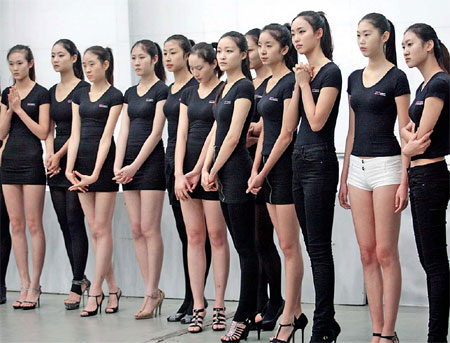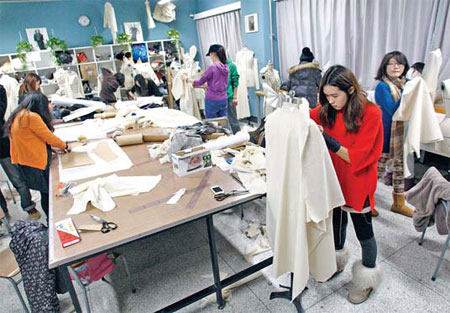School of style
Updated: 2012-01-10 08:13
By Gan Tian (China Daily)
|
|||||||||||
|
|
|
|

The growth of the Beijing Institute of Fashion Technology runs parallel to that of the country's fashion industry. Gan Tian reports.
The music stops, and someone angrily howls at 18-year-old Hu Naiyue, as she strikes a pose and flashes a smile on the runway. "You are showcasing an evening dress, so I need you to be elegant, but you're acting like a woman athlete!" Offstage, young designers are dashing from room to room, rulers and mannequins in tow, measuring, cutting and sewing.
While the scene could be from an episode of Next Top Super Model or Project Runway, it's actually a group of Beijing Institute of Fashion Technology (BIFT) students doing their homework.
BIFT ranks among China's most celebrated fashion colleges and is often hailed as the country's answer to Saint Martin's University or Parsons.
It has produced more than 50,000 graduates in the past three decades, many of whom have gone on to become pillars of the country's fashion industry - designers, editors and critics.
Students strut about the campus as if it were a catwalk, clad in Gucci and Fendi outfits, or their own designs.
Deputy dean of BIFT's school of fashion art and engineering department Wang Qi says: "The history of the institute is the history of China's fashion industry."
Fashion didn't really exist as a concept when the institute was founded in 1959. At that time, nearly everyone wore blue and gray Mao suits.
The school was then called the Beijing Textile Engineering Institute and was affiliated with the Ministry of Textiles. It mostly provided courses about textile technologies - but not about style.
BIFT began offering fashion courses in 1987 and assumed its current name a year later.
That was when the country's fashion industry was born.
Zheng Rong was one of the 27 students enrolled in 1987.
Zheng recalls there weren't enough teachers specialized in design at first. Most instructors were experts in textile technologies from such educational institutions as the Suzhou Institute of Silk Textile Technology (now Soochow University), Zhejiang Silk Industrial College (now Zhejiang Sci-Tech University) and Tianjin Textile Technology College (now Tianjin Polytechnic University).
"But we could see some local fashion companies were starting up at that time, and society was beginning to pay attention to fashion," Zheng recalls.
Fashion began to take off in the early 1990s - not only in terms of design but also in terms of modeling, publishing and branding.
Zhao Danhui was one of the first BIFT students to major in modeling. The major was introduced in 1993, and Zhao enrolled in 1995, learning how to stroll on the catwalk, dance to ballet and master cosmetics.
She recalls her 20 classmates were all women who were taller than 1.73 meters.
One homework assignment in 1997 was to take to the catwalk for Beijing Fashion Week.
Zhao recalls that, as a young student, she didn't have enough money to take a taxi from one show to another. When she boarded a bus runway-ready, a stranger asked: "Aren't you a rich and famous model? Why are you taking the bus?"
Fashion modeling and communication department dean Xiao Bin says the major was introduced just in time, as the international runway needs more Chinese. But most Chinese models on the global stage then hadn't received professional training.
"BIFT modeling majors had to attend classes like fashion design, ballet dancing and photography," Xiao says.
"After this training, they're more confident and know how to truly showcase clothing."
Yang Jie, who enrolled as a fashion design major in 2000, believes he enjoyed more opportunities than Zheng and Zhao.
He learned more than fashion design during his four years at BIFT, he says. Yang's instructors also had students design fashion label advertisements and brainstorm boutique store decoration schemes.
That gave him the idea - and the skills - to start his own label.
So Yang founded Pok Poker in 2004. His designs qualified him as the first Chinese student to earn a scholarship from Italy's Instituto Europeo di Design.
Wang says BIFT provides not only educations but also "practical" job opportunities.
"BIFT was born at the start of, and has grown during, the rise of China's fashion industry," he says.
"This creates so many chances for the students."
Wang says it's difficult for a young graduate from Saint Martin's or Parsons to start a label, because the fashion industries of Britain and the US are mature.
But the rapid growth of China's fashion industry provides space for them.
Zhao, the modeling major, is now the manager of Rich Public Relations Company, which helps Chinese fashion labels host shows. She says doing business is easy, because many of her clients are her classmates.
Lan Yu, who graduated from BIFT three years ago, is considered the country's Vera Wang.
As one of the country's top fashion designers, she has made wedding dresses for A-listers, including Huang Shengyi, Li Xiang and Xie Na.
See "Fashion" Page 20
Today's Top News
Rescuers race against time for quake victims
Telecom workers restore links
Coal mine blast kills 18 in Jilin
Intl scholarship puts China on the map
More bird flu patients discharged
Gold loses sheen, but still a safe bet
US 'turns blind eye to human rights'
Telecom workers restore links
Hot Topics
Lunar probe , China growth forecasts, Emission rules get tougher, China seen through 'colored lens', International board,
Editor's Picks

|

|

|

|

|

|







